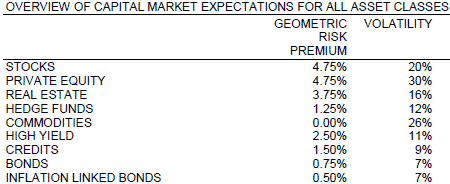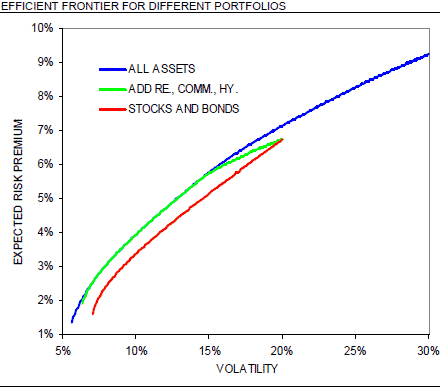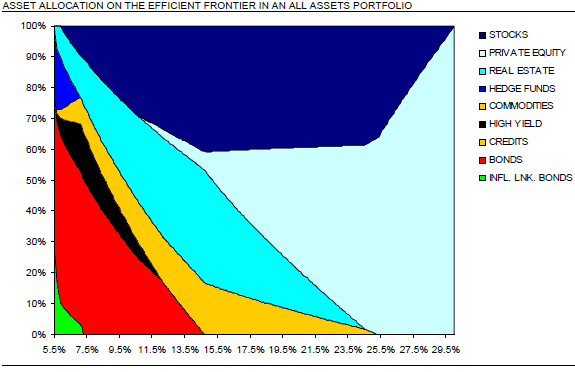Based on Modern Portfolio Theory (MPT) and inferences from historical asset class returns, what are the best portfolio allocations for different levels of risk? In their February 2009 paper entitled “Strategic Asset Allocation: Determining the Optimal Portfolio with Ten Asset Classes”, Niels Bekkers, Ronald Doeswijk and Trevin Lam explore which asset classes add mean-variance diversification value to a traditional portfolio of stocks, bonds and cash and determine the weights of asset classes in optimal portfolios (maximum Sharpe ratio). Their total set of ten asset classes consists of stocks, government bonds, cash, private equity, real estate, hedge funds, commodities, high yield bonds, credits and inflation-linked bonds. Using mostly U.S. data as available for historical asset class returns and volatilities, they conclude that:
- Expected geometric mean risk premiums vary from 0% for commodities to 4.75% for stocks and private equity. Annualized volatilities range from 7% for government bonds and inflation-linked bonds to 30% for private equity. (See the table below.)
- The greatest boost to annual Sharpe ratio (about 0.35 to 0.40) compared to the traditional mix of stocks, government bonds and cash comes from adding real estate, commodities and high yield bonds to the portfolio. (See the first chart below).
- Hedge funds and private equity have little value in the low-middle range of portfolio volatilities (See the second chart below.)
The following table, excerpted from the paper, lists estimates for the expected risk premiums and volatilities (standard deviations of annual returns) for all non-cash asset classes. The authors note that these estimates involve subjective judgments, and long-term data does not exist for some asset classes. Different judgments might produce substantially different MPT allocations. Appendix A of the paper provides rationales for these values and historical correlations between asset classes.

The following chart, taken from the paper, depicts the benefits of adding real estate, commodities and high yield bonds (RE, COMM., HY.) to a traditional portfolio of stocks, bonds and cash. The Sharpe ratio for the optimal stocks-bonds-cash portfolio (red curve) is about 0.35, compared to about 0.40 for the optimal portfolio employing all ten asset classes (blue curve). For the portfolio volatility range of 7% to 20%, adding real estate, commodities and high yield bonds comes close to the value of an all-asset portfolio, boosting returns by 0.40% to 0.93% per year.

The next chart, also from the paper, shows the MPT-optimal asset allocation for an all-asset portfolio (vertical axis) given annual volatilities ranging from 5.5% to 30% (horizontal axis). For the least risky allocation, about 78% of portfolio funds are in fixed-income assets, including inflation-linked bonds. Stocks, government bonds, real estate, commodities and high yield bonds (but not private equity or hedge funds) earn significant allocations for portfolio volatilities in the range 7.5%-12.5%. For riskier portfolios, private equity sequentially displaces bonds, real estate, commodities and stocks.

In summary, investors with low-middle risk tolerance may accrue significant diversification benefits from adding proxies for real estate, commodities and high yield bonds to traditional portfolios of stocks, government bonds and cash.
The behavior and interplay of asset classes may vary over time, changing the optimal portfolio allocations. Also, the above analysis assumes, contrary to some empirical data, that distributions of financial market returns are “tame.”